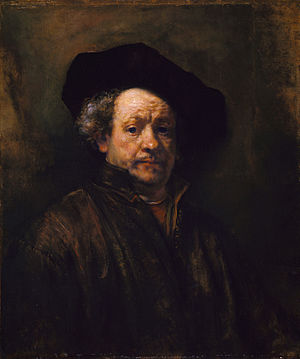Description
The Altman portrait is dated 1660, when Rembrandt was fifty-four years old. This was an anxious year for him. He had just been declared bankrupt. His collection of art treasures was sold at auction. Meanwhile his pupils and friends distanced themselves from him. He also lost his studio space. In this portrait we have a work of mature years, when he brought all the skill and resources of a lifetime to its creation. [1] The lift of the eyebrows that wrinkle his forehead is that of whimsical impatience, yet the spark in his eyes denies defeat. The mouth is drawn and the mark of undeserved neglect is evident in the premature wrinkles, but a certain merry pride lurks in the tilted cap and raised head. A pang of pity shoots through us, only to be replaced by one of keen satisfaction that he, the neglected, is remembered and they, the aristocrats, are forgotten. [2] Though Rembrandt lived several years longer, they were years of misery, and he painted only one more great work, the group portrait "Syndics of the Drapers' Guild," now in the Rijksmuseum in Amsterdam. His great reputation suffered an almost total eclipse, although to-day he is probably the most popular painter that ever lived. Yet he never lost his courage, and as we see him in this portrait he carries his head bravely and wears his hat jauntily, as if in defiance of the evils that engulfed him. Heretofore we may have felt acquainted with Rembrandt the painter, but now we know Rembrandt the man; for just so he must have looked to his neighbors in the troublous year 1660. [1]
Composition
A 1913 article said: "Technically this portrait shows Rembrandt at his best. The hat, a rich black, and the background, a warm green, are smoothly painted. The shadows in the face are thin, warm, and transparent, while the lighter parts, as on the cheek, are laid on with a well-loaded brush, suggesting the texture of the flesh and made to glow with color. Over a red waistcoat Rembrandt wears a heavy, brownish coat". [1]
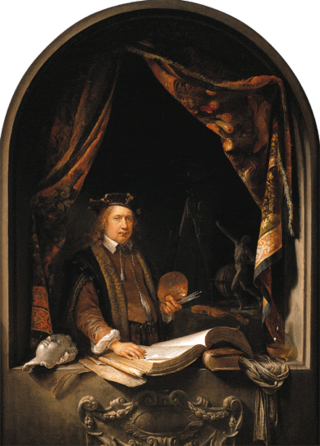
Gerrit Dou, also known as GerardDouw or Dow, was a Dutch Golden Age painter, whose small, highly polished paintings are typical of the Leiden fijnschilders. He specialised in genre scenes and is noted for his trompe-l'œil "niche" paintings and candlelit night-scenes with strong chiaroscuro. He was a student of Rembrandt.

Nicolaes Maes was a Dutch painter known for his genre scenes, portraits, religious compositions and the occasional still life. A pupil of Rembrandt in Amsterdam, he returned to work in his native city of Dordrecht for 20 years. In the latter part of his career he returned to Amsterdam where he became the leading portrait painter of his time. Maes contributed to the development of genre painting in the Netherlands and was the most prominent portrait painter working in Amsterdam in the final three decades of the 17th century.

Admiral William Waldegrave, 1st Baron Radstock, GCB was an officer in the Royal Navy and Governor of Newfoundland.

Rembrandt Harmenszoon van Rijn, usually simply known as Rembrandt, was a Dutch Golden Age painter, printmaker, and draughtsman. He is generally considered one of the greatest visual artists in the history of art. It is estimated Rembrandt produced a total of about three hundred paintings, three hundred etchings, and two thousand drawings.
Alexander Hugh Baring, 4th Baron Ashburton, was a British landowner and Conservative Party politician.
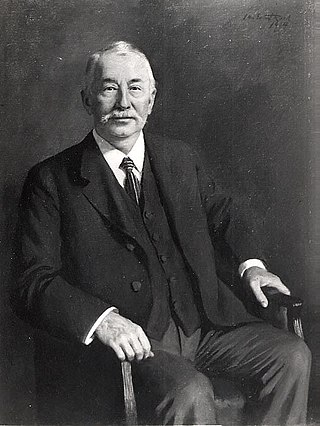
Benjamin Altman was a New York City department store owner and art collector who is best known today for his large art collection, which he donated to the Metropolitan Museum of Art.

Aristotle with a Bust of Homer, also known as Aristotle Contemplating a Bust of Homer, is an oil-on-canvas painting by Rembrandt that depicts Aristotle wearing a gold chain and contemplating a sculpted bust of Homer. It was created as a commission for Don Antonio Ruffo's collection. It was bought and sold by several collectors until it was eventually purchased by the Metropolitan Museum of Art. The mysterious tone in the painting has led several scholars to different interpretations of Rembrandt's theme.

Charles Sedelmeyer was an Austrian and French art dealer, collector, and publisher active in Paris from 1866, with premises at 6 rue de la Rochefoucauld.

A Girl Asleep, also known as A Woman Asleep, A Woman Asleep at Table, and A Maid Asleep, is a painting by the Dutch master Johannes Vermeer, created c. 1657. It is now in the Metropolitan Museum of Art in New York City and may not be lent elsewhere under the terms of the donor's bequest.

This 1629 self-portrait by Dutch painter Rembrandt van Rijn is part of the Clowes Fund Collection of the Indianapolis Museum of Art in Indianapolis, Indiana. It is among the earliest of over 40 self-portraits by Rembrandt, which he produced over the course of four decades.

Old Man with a Gold Chain is a portrait by Rembrandt, painted around 1631 and now in the Art Institute of Chicago.

Portrait of Jan Six is a 1654 oil-on-canvas painting by the Dutch painter Rembrandt van Rijn. Having been handed down many generations, via the direct descendants of the portrait's subject, Jan Six, the work remains in the Six Collection in Amsterdam.
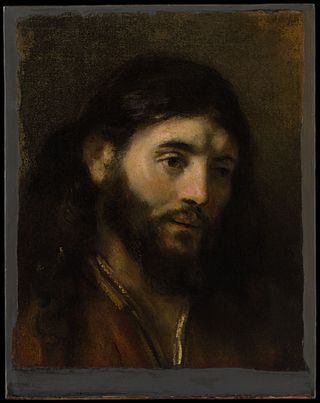
Head of Christ is a 1650s painting by Rembrandt's workshop. It shows Christ with a beard and long dark hair. It is in the collection of the Metropolitan Museum of Art.

Portrait of a Man, probably a Member of the Van Beresteyn Family is an oil-on-canvas 1632 portrait painting by Rembrandt. It shows a man with a lace collar, which was a new fashion in the 1630s replacing older-styled millstone collars. It is pendant to Portrait of a Woman, probably a Member of the Van Beresteyn Family, and both are in the collection of the Metropolitan Museum of Art.

Oval Portrait of a Woman is a 1633 portrait painting painted by Rembrandt. It shows a woman with a millstone collar and diadem cap. It is in the collection of the Metropolitan Museum of Art.

Young Woman in a Pearl Necklace is an oil on canvas painting by the Dutch painter Willem Drost. It is an example of Dutch Golden Age painting and is part of the collection of Gemäldegalerie Alte Meister.

Young Woman in a Pearl Necklace is an oil on canvas painting by an unknown painter, after a painting by the Dutch painter Willem Drost. It is an example of Dutch Golden Age painting and is part of the collection of the Metropolitan Museum of Art.

Christ with a Staff or St James the Less is a painting by a follower of Rembrandt, now in the Metropolitan Museum of Art. It was also known as Christ in 1854 and exhibited in 1933 as The Pilgrim.

Portrait of a Man Holding Gloves is a 1648 oil on mahogany panel portrait by Rembrandt, now in the Metropolitan Museum of Art in New York.
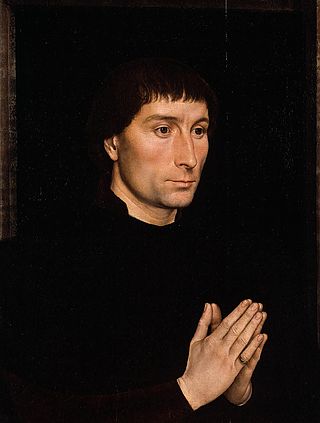
Portrait of Tommaso Portinari by Hans Memling is held by the Metropolitan Museum of Art, New York City. It was made c.1470 in oil on oak panel, and measures 44.1 by 33.7 centimetres. The painting and Memling's Portrait of Maria Portinari form the wings from a since dismantled triptych; the central panel is believed to have been a now lost depiction of the Madonna and Child; perhaps Memling's Virgin and Child in the National Gallery, London.
